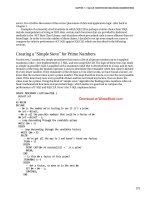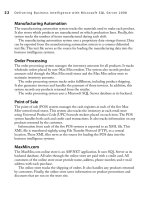SQL Server DMVs in Action pptx
Bạn đang xem bản rút gọn của tài liệu. Xem và tải ngay bản đầy đủ của tài liệu tại đây (12.77 MB, 355 trang )
MANNING
Ian W. Stirk
Better queries with
Dynamic Management Views
www.it-ebooks.info
SQL Server DMVs in Action
www.it-ebooks.info
www.it-ebooks.info
SQL Server
DMVs in Action
BETTER QUERIES WITH
DYNAMIC MANAGEMENT VIEWS
IAN W. STIRK
MANNING
Shelter Island
www.it-ebooks.info
For online information and ordering of this and other Manning books, please visit
www.manning.com. The publisher offers discounts on this book when ordered in quantity.
For more information, please contact
Special Sales Department
Manning Publications Co.
20 Baldwin Road
PO Box 261
Shelter Island, NY 11964
Email:
©2011 by Manning Publications Co. All rights reserved.
No part of this publication may be reproduced, stored in a retrieval system, or transmitted, in
any form or by means electronic, mechanical, photocopying, or otherwise, without prior written
permission of the publisher.
Many of the designations used by manufacturers and sellers to distinguish their products are
claimed as trademarks. Where those designations appear in the book, and Manning
Publications was aware of a trademark claim, the designations have been printed in initial caps
or all caps.
Recognizing the importance of preserving what has been written, it is Manning’s policy to have
the books we publish printed on acid-free paper, and we exert our best efforts to that end.
Recognizing also our responsibility to conserve the resources of our planet, Manning books
are printed on paper that is at least 15 percent recycled and processed without the use of
elemental chlorine.
Manning Publications Co. Development editor: Katharine Osborne
20 Baldwin Road Copyeditor: Linda Recktenwald
PO Box 261 Proofreader: Katie Tennant
Shelter Island, NY 11964 Typesetter: Dennis Dalinnik
Cover designer: Marija Tudor
ISBN: 9781935182733
Printed in the United States of America
12345678910 –MAL–17161514131211
www.it-ebooks.info
To Joan, Karen, and Catherine,
for yesterday, today, and tomorrow
www.it-ebooks.info
www.it-ebooks.info
vii
brief contents
PART 1 STARTING THE JOURNEY. 1
1 ■ The Dynamic Management Views gold mine 3
2 ■ Common patterns 31
PART 2 DMV DISCOVERY 53
3 ■ Index DMVs 55
4 ■ Improving poor query performance 92
5 ■ Further query improvements 118
6 ■ Operating system DMVs 147
7 ■ Common Language Runtime DMVs 174
8 ■ Resolving transaction issues 196
9 ■ Database-level DMVs 226
10 ■ The self-healing database 257
11 ■ Useful scripts 285
www.it-ebooks.info
www.it-ebooks.info
ix
contents
preface xix
acknowledgements xx
about this book xxii
PART 1 STARTING THE JOURNEY 1
1
The Dynamic Management Views gold mine 3
1.1 What are Dynamic Management Views? 4
A glimpse into SQL Server’s internal data 7
Aggregated results 8
■
Impact of running DMVs 8
Part of SQL Server 2005 onward 8
1.2 The problems DMVs can solve 9
Diagnosing problems 9
■
Performance tuning 10
Monitoring 10
1.3 DMV examples 13
Find your slowest queries 14
■
Find those
missing indexes 15
■
Identify what SQL statements are
running now 17
■
Quickly find a cached plan 18
1.4 Preparing to use DMVs 22
Permissions 22
■
Clearing DMVs 22
www.it-ebooks.info
CONTENTS
x
1.5 DMV companions 23
Catalog views 24
■
Cached plans 24
Indexes 25
■
Statistics 25
1.6 Working with DMVs 26
In context with other tools 26
■
Self-healing
database 28
■
Reporting and transactional databases 29
1.7 Summary 30
2
Common patterns 31
2.1 Reducing blocking 32
2.2 Using CROSS APPLY 32
2.3 Restricting output to a given database 32
2.4 Restricting output by using the TOP command 33
2.5 Creating an empty temporary table structure 34
2.6 Looping over the databases on a server 35
2.7 Retrieving a query’s cached plan and SQL text 37
2.8 Extracting the Individual Query from the
Parent Query 38
2.9 Identifying the database used by ad hoc queries 39
2.10 Calculating DMV changes 40
2.11 Reading cached plans 43
Targeting the area of concern 43
■
Things to look out for 44
2.12 Building dynamic SQL 47
2.13 Printing the content of large variables 48
2.14 Common terms and acronyms 49
2.15 Known problems that may affect the scripts 50
SQL Server compatibility level set to below 2005 50
An OFFLINE database 50
2.16 Summary 51
PART 2 DMV DISCOVERY 53
3
Index DMVs 55
3.1 The importance of indexes 56
Types of index 56
■
Types of index access 57
Factors affecting index performance 58
www.it-ebooks.info
CONTENTS
xi
3.2 Costly missing indexes 62
Finding the most important missing indexes 62
■
The impact
of missing indexes 64
3.3 Unused indexes 65
Finding the most-costly unused indexes 66
■
The impact
of unused indexes 68
3.4 High-maintenance indexes 69
Finding the top high-maintenance indexes 69
■
The impact
of high-maintenance indexes 71
3.5 Most-frequently used indexes 72
Finding the most-used indexes 72
■
The importance
of the most-used indexes 74
3.6 Fragmented indexes 75
Finding the most-fragmented indexes 75
■
The impact
of fragmented indexes 77
3.7 Indexes used by a given routine 78
Finding the indexes used by a given routine 78
The importance of knowing which indexes are used 81
3.8 Databases with most missing indexes 83
Finding which databases have the most missing indexes 84
The importance of other databases 84
3.9 Completely unused indexes 85
Finding which indexes aren’t used at all 85
■
The importance
of unused indexes 87
3.10 Your statistics 87
Finding the state of your statistics 88
■
The importance
of statistics 89
3.11 A holistic approach to managing indexes 90
3.12 Summary 91
4
Improving poor query performance 92
4.1 Understanding executed queries 93
Aggregated results 93
■
Clearing the cached plans 93
4.2 Finding a cached plan 94
How to find a cached plan 94
www.it-ebooks.info
CONTENTS
xii
4.3 Finding where a query is used 97
Identifying where a query is used 97
4.4 Long-running queries 98
Finding the queries that take the longest time to run 99
The impact of long-running queries 101
4.5 Queries that spend a long time being blocked 103
Finding the queries that spend the longest time being blocked 104
4.6 CPU-intensive queries 106
Finding the queries that use the most CPU 106
4.7 I/O-hungry queries 108
Finding the queries that use the most I/O 109
Reducing the impact of queries that use the most I/O 110
4.8 Frequently executed queries 111
Finding the queries that have been executed the most often 111
Reducing the impact of queries that are executed most often 113
4.9 The last run of a query 114
Determining when a query was last run 114
■
Variations on
searching for queries 115
4.10 Summary 116
5
Further query improvements 118
5.1 Queries with missing statistics 119
Finding queries that have missing statistics 119
■
The importance
of statistics 121
■
Default statistics properties 122
5.2 Finding queries that have missing indexes 123
5.3 Finding queries that have implicit data type
conversions 124
Finding implicit data conversions 125
■
Finding disparate
column data types 125
5.4 Finding queries that have table scans 127
5.5 Slower-than-normal queries 127
Finding queries that are running slower than normal 128
The importance of queries that are running slower
than normal 131
5.6 Unused stored procedures (2008 only) 132
Finding unused stored procedures 133
www.it-ebooks.info
CONTENTS
xiii
5.7 Looking for SQL queries run during a
specific interval 134
What runs over a given time period? 134
5.8 Relationships between DMV snapshot deltas 137
Amalgamated DMV snapshots 137
5.9 Currently running queries 142
What’s running now? 142
5.10 Recompiled queries 144
Finding the most-recompiled queries 144
5.11 Summary 146
6
Operating system DMVs 147
6.1 Understanding server waits 148
6.2 Identifying your most common waits 148
Why are you waiting? 149
■
Common wait types 151
6.3 Identifying your most common waits—snapshot
version 152
Why are you waiting? (snapshot version) 153
6.4 Identifying why queries wait 154
Discovering why your queries are waiting 154
6.5 Queries that are waiting 157
6.6 Finding what’s blocking running SQL 158
What’s blocking my SQL query? 158
6.7 SQL Server performance counters 160
Important non-SQL performance counters 162
6.8 Effect of running SQL queries on the performance
counters 164
6.9 How performance counters and wait states relate 165
6.10 SQL queries and how they change the performance
counters and wait states 168
6.11 Correlating wait states and performance counters 171
6.12 Capturing DMV data periodically 172
6.13 Summary 173
www.it-ebooks.info
CONTENTS
xiv
7
Common Language Runtime DMVs 174
7.1 Introducing the CLR 175
7.2 A simple CLR example 176
Creating a simple CLR class 176
■
Using the SQL CLR
regular expression functions 179
7.3 .NET Framework performance concerns 181
7.4 Time-consuming CLR queries 183
Finding the queries that spend the most time in the CLR 183
Impact of time-consuming CLR queries 185
7.5 Queries spending the most time in the CLR
(snapshot version) 186
Finding queries that spend the most time in the CLR
(snapshot version) 186
7.6 Relationships between CLR DMVs and other DMVs 188
7.7 Getting information about SQL Server CLR
integration 192
7.8 Getting information about your SQL CLR
assemblies 193
7.9 Summary 195
8
Resolving transaction issues 196
8.1 Transaction overview 197
8.2 A simple transaction-based case study 198
8.3 Locks, blocks, and deadlocks 200
Locks 200
■
Blocks 202
■
Deadlocks 203
8.4 The ACID properties of transactions 205
8.5 Transaction isolation levels 205
8.6 Sessions, connections, and requests 206
8.7 Finding locks 207
8.8 Identifying the contended resources 209
Contended resources—basic version 209
■
Contended resources—
enhanced version 210
8.9 Identifying inactive sessions with open transactions 212
How idle sessions with open transactions arise 213
■
How to find
an idle session with an open transaction 213
www.it-ebooks.info
CONTENTS
xv
8.10 Waiting due to transaction locks 214
Waiting because of an idle session with an
open transaction 215
■
Waiting because of active session
transactions only 217
■
Waiting because of both active
and idle session transactions 218
8.11 Queries waiting for more than 30 seconds 219
8.12 Lock escalation 220
8.13 How to reduce blocking 221
8.14 How to reduce deadlocks 224
8.15 Summary 225
9
Database-level DMVs 226
9.1 Space usage in tempdb 227
What is tempdb? 227
■
Total, free, and used space
in tempdb 228
■
Tempdb total space usage by object type 230
9.2 Session usage in tempdb 231
Session usage of tempdb space 232
■
Space used and not reclaimed
in tempdb by session 233
9.3 Task usage in tempdb 235
Space used by running SQL queries 235
■
Space used and not
reclaimed by active SQL queries 237
9.4 Tempdb recommendations 239
9.5 Index contention 240
Indexes under row-locking pressure 241
Escalated indexes 243
■
Unsuccessful index-lock
promotions 244
■
Indexes with the most
page splits 245
■
Indexes with most latch contention 247
Indexes with most page I/O-latch contention 248
■
Indexes under
row-locking pressure—snapshot version 249
■
How many rows
are being inserted/deleted/updated/selected? 252
9.6 Summary 256
10
The self-healing database 257
10.1 Self-healing database 258
10.2 Recompiling slow routines 259
Recompiling routines that are running slower than usual 259
www.it-ebooks.info
CONTENTS
xvi
10.3 Automatically rebuild and reorganize indexes 264
Rebuilding and reorganizing fragmented indexes 264
10.4 Intelligently update statistics 268
Simple intelligent statistics update 269
■
Time-based intelligent
statistics update 272
10.5 Automatically updating a routine’s statistics 276
10.6 Automatically implement missing indexes 279
Implementing missing indexes 279
10.7 Automatically disable or drop unused indexes 281
Disabling or dropping unused indexes 282
10.8 Summary 284
11
Useful scripts 285
11.1 Viewing everyone’s last-run SQL query 286
Find the last-run queries 286
11.2 A generic performance test harness 287
Using the generic performance test harness 288
11.3 Determining the impact of a system upgrade 290
Quantifying system upgrade impact 290
11.4 Estimating the finishing time of system jobs 293
Estimating when a job will end 294
11.5 Get system information from within SQL Server 295
11.6 Viewing enabled Enterprise features (2008 only) 297
11.7 Who’s doing what and when? 298
11.8 Finding where your query really spends its time 300
Locating where your queries are spending their time 300
11.9 Memory usage per database 303
Determining the memory used per database 303
11.10 Memory usage by table or index 304
Determining the memory used by tables and indexes 304
11.11 Finding I/O waits 307
I/O waits at the database level 307
■
I/O waits at the
file level 308
■
Average read/write times per file,
per database 310
www.it-ebooks.info
CONTENTS
xvii
11.12 A simple lightweight trace utility 311
11.13 Some best practices 313
11.14 Where to start with performance problems 314
Starting with a slow server or database 314
■
Starting with
slow queries 315
11.15 Summary 316
index 317
www.it-ebooks.info
www.it-ebooks.info
xix
preface
When I first discovered DMVs, I was enthralled because they made many difficult
things so easy. It was simple to identify, typically within seconds, the core perfor-
mance problems that affect SQL Server databases. For example, I could quickly
discover which queries were taking the longest time to run, which indexes were miss-
ing, and why queries were being blocked. This was only the tip of the iceberg; the
deeper I dug into DMVs, the more information they provided to help me fix perfor-
mance problems.
Although I was captivated by the power of DMVs, I was frustrated because there was
very little awareness, even among experienced DBAs, of their existence. In response to
this I wrote an article for Microsoft’s MSDN magazine that was published in January
2008, which showed how useful DMVs could be. I then waited, expecting someone to
write a book about the subject.
Time passed, and although several articles about DMVs were subsequently pub-
lished, the book I wanted to read was not forthcoming. So late in 2009 I contacted
Manning Publications to discuss the possibility of writing such a book. You’re now
holding the fruit of that conversation.
I’m confident this book will help you successfully identify and target your perfor-
mance problems as well as suggest solutions to these problems, giving you better-
performing SQL Server databases.
It’s heartening to hear comments from people when they first discover the power
of DMVs; they too are amazed at how easily DMVs can help identify problems and pro-
pose possible solutions to these problems. Like me, they’re probably mystified why
DMVs aren’t more widely used. I hope this book will help correct this situation.
www.it-ebooks.info
xx
acknowledgements
I’d like to start off by thanking the whole Manning team, in particular Katharine
Osborne, Michael Stephens, Marjan Bace, Mary Piergies, Janet Vail, Linda Reckten-
wald, Katie Tennant, and Dennis Dalinnik. Thank you, Katharine, for your profession-
alism and steering me in the right direction, and thank you Michael and Marjan for
believing the subject of DMVs could make an important contribution to improving
SQL performance. I’m indebted to the Manning production team, Mary, Janet, Linda,
Katie, and Dennis, for guiding me through the production process and helping make
this a better book.
I’d like to express my thanks to Elvira Chierkoet, for checking and reading every
sentence and helping ensure my ideas were sensible.
To the technical reviewers, I want to thank you for your feedback and for making
this a more accurate book: Tariq Ahmed, Christian Siegers, Nikander Bruggeman,
Margriet Bruggeman, Amos Bannister, Richard Siddaway, Sumit Pal, Dave Corun, and
Sanchet Dighe, and special thanks to the main technical reviewer, Deepak Vohra.
I want to give a special thank-you to Karen Stirk, Catherine Stirk, and Charlie for
their support and encouragement. A special thank-you is owed to my grandparents,
Joan and Bill Bridgewater, and the rest of the Bridgewater family (Karen, Timmy,
Brenda, Caroline, Kenny, Patty, Jenny, Mary, Jacky, David, and Diane). And thanks also
to my old chemistry teacher, Jim Galbraith. Without these people, I would have
turned out a lesser person.
I’ve been lucky enough to know some interesting and helpful people, both as
friends and colleagues, and I’d like to thank you all: Tim Noakes, Dave Starkey,
www.it-ebooks.info
ACKNOWLEDGEMENTS
xxi
Mark Hadley, Gerald Hemming, Albert Morris, Martin Gunning, Chris Conn, Roy
Carter, Mark Woodward, Kevin Bowen, Lee Humphries, Steven Hines, Gus Oliver,
Jason Hales, Marina Barbosa, Mark Barrett, Chris Ambrose, John Dillon, Jeremy
Braithwaite, Ken Piddlesden, Steve Forrester, Maria Lynch, Ernie French, Chris
Cuddy, Sean Farmer, Michael O’Boyle, Ione Farias, Suresh Konduru, Francis Spencer,
Iain Roy, Paul Williams, Doug Victor, Paul Weeks, John Cousins, Dale Rainsford,
Scott Eggert, Julie Mathews, Pierre Bressollette, Manuel Dambrine, Alexander
Godschalk, Lars Grønkjær, Raimond Bakkes, Yan Huang, Chris Homer, Lasse Lundby
Franck, Andy van Dongen, Shobha Mittal, Jeroen Ameling, Alek Kudic, Ruud
Lemmers, Henk Leppers, Patricia Pena Torres, David Fanning, Mike Diment, Livia
Raele, Raj Kissan, Alex Rougge, David Barker, Ron Finch, Tina Simon, John
Predgen, Dave Fisher, Phil Fielding, Brian Wright, Maria Iturburu, Jerome Farnon,
Harbans Heer, David Randall, Bruce Pitman, Lawrence Moore, Manal Koujan, Mike
Bowler, Angela Dedeng, Russell Case, Cornelius van Berkel, Sarah Hamed, and
Michael Hipkin.
www.it-ebooks.info
xxii
about this book
This book captures a wealth of experience that can be used along with code snip-
pets to immediately improve the performance of your databases. SQL Server is find-
ing its way into an increasing number of businesses. Although most servers are
conspicuous, some appear almost hidden, for example, SharePoint servers and Cus-
tomer Relationship Management (CRM) servers. In addition, increasing amounts of
data are getting stored within SQL Server. Both of these trends have a bearing on the
performance of your SQL Server databases and queries. You can use the advice and
code snippets given in this book to fight back and reclaim your high-performing
SQL Server.
Who should read this book?
If you want to improve the performance of your SQL Server databases and the queries
that run on them, you should buy this book.
Anyone who wants to ensure their SQL Server databases are running as effi-
ciently as possible will find this book very useful. The following groups of people in
particular will find this book valuable: database administrators (DBAs), developers
working with SQL Server, and administrators of SharePoint servers, CRM systems, and
similar servers.
When a new version of a software product appears, for example, Microsoft Word or
SQL Server, new features are typically added to the existing core. Microsoft Word is
still primarily used to enter and store text; this core functionality hasn’t changed,
despite the numerous version releases. Similarly, although this book is written primarily
www.it-ebooks.info
ABOUT THIS BOOK
xxiii
for SQL Server 2005 and 2008, the core functionality of the DMVs is unlikely to
change in future versions (for example, SQL Server 2011), and so it should be applica-
ble to future versions too.
DBAs need to ensure the databases under their command are running as efficiently
as possible. Running the code snippets provided in this book will identify any problem
areas and help provide solutions to these problems.
Developers need to ensure their applications can retrieve and store data efficiently.
Using the supplied code snippets, developers will be able to ensure appropriate
indexes are being used, the data is being retrieved efficiently, and any changes are
tested for defined improvement.
Increasingly, SharePoint servers, CRM servers, and similar servers that have SQL
Server as their underlying database are being installed in organizations with little
thought for ongoing maintenance. With time, the performance of these unattended
servers can degrade. Applying the code snippets included in this book will identify
areas where performance can be improved.
One final point: Often organizations install third-party applications on their SQL
Servers. Although it’s usually not possible to change the code in these applications, it
is possible to run the code snippets in this book against these databases, with a view to
either applying any missing indexes (if this is allowed) or providing feedback to the
third party to make the required changes.
Roadmap
This book contains 100-plus code snippets to help you investigate your SQL Server data-
bases. In addition to identifying the problem areas, potential solutions are discussed.
The book is divided into two sections. The first section provides an overview of
what DMVs are and how they can identify and solve problems easily and quickly. In
addition, this section contains details of common patterns that are used throughout
the rest of the book. The second section contains scripts and discussions for improv-
ing performance relating to indexes, queries, the operating system, the Common Lan-
guage Runtime (CLR), transactions, space usage, and much more. Using the code
snippets and advice given in this section will provide you with a more optimally per-
forming SQL Server.
Chapter 1 provides an overview of the power of DMVs. It shows you what DMVs are
and why they’re important. Various examples are given to get you investigating your
performance problems in seconds. Structures such as indexes and statistics are dis-
cussed in the context of DMVs. Finally, DMVs are discussed in the context of other per-
formance tools.
Chapter 2 discusses common patterns that are used throughout the book. Rather
than describing these patterns everywhere, they are discussed once in this chapter and
referenced in the rest of the book.
www.it-ebooks.info
ABOUT THIS BOOK
xxiv
Chapter 3 looks at index-based DMVs. Indexes are a great tool for improving the
performance of your SQL queries. However, unused or little-used indexes can have a
detrimental effect on performance. The code snippets included in this chapter will
help you improve your index usage, resulting in improved SQL queries.
Chapter 4 takes a look at DMVs that relate to your queries. Code snippets are pro-
vided to identify your slowest-running queries, queries that are blocked the most, que-
ries that use the most CPU, and queries that use the most I/O. All these snippets allow
you to investigate performance problems from differing viewpoints.
Chapter 5 is an extension of chapter 4, discussing further aspects of how to
improve the performance of your queries.
Chapter 6 relates to operating system DMVs. It discusses why your queries, as a
whole, are not able to run, what resources they’re waiting for, and how these resources
can be improved to give faster queries. Windows performance counters are also exam-
ined in relation to these collective queries.
Chapter 7 focuses on the Common Language Runtime DMVs. The use of the CLR
within SQL Server is illustrated with a CLR class that provides regular expression func-
tionality for use within your own SQL queries.
Chapter 8 opens with a look at transactions, locking, blocking, and deadlocks. A
small case study is provided to illustrate the transaction-based DMV code snippets.
Ways of reducing both blocking and deadlocking are explored.
Chapter 9 discusses database-related DMVs. The first section discusses the impor-
tance of tempdb and shows how to examine its usage when space problems arise. The
second section examines various aspects of index usage that can help you diagnose
and improve your queries.
Chapter 10 contains code snippets that can be used to automatically improve the
performance of your SQL Server databases. Snippets include intelligently updating
statistics, recompiling slow routines, and implementing missing indexes.
Chapter 11 has useful snippets that don’t fit into any of the other chapters. The
snippets include a generic test harness, estimating the finishing time of jobs, how
memory is used by your database, and a simple lightweight DMV trace utility.
Code conventions and downloads
All source code in listings or set off from the text is in a
fixed-width
font
like
this
to separate it from ordinary text. Code annotations accompany many of the listings,
highlighting important concepts. In some cases, numbered bullets link to explana-
tions that follow the listing.
The source code for all of the examples in the book is available from the pub-
lisher’s website at www.manning.com/SQLServerDMVsinAction.
www.it-ebooks.info









